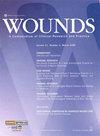Comparison of wound surface area measurements obtained using clinically validated artificial intelligence-based technology versus manual methods and the effect of measurement method on debridement code reimbursement cost.
IF 1.4
4区 医学
Q3 DERMATOLOGY
Wounds : a compendium of clinical research and practice
Pub Date : 2023-10-01
DOI:10.25270/wnds/23031
引用次数: 0
Abstract
BACKGROUND Evidence shows that ongoing accurate wound assessments using valid and reliable measurement methods is essential to effective wound monitoring and better wound care management. Relying on subjective interpretation in measuring wound dimensions and assuming a rectilinear shape of all wounds renders an inconsistent and inaccurate wound area measurement. OBJECTIVE The authors investigated the discrepancy in wound area measurements using a DWMS versus TPR methods and compared debridement codes submitted for reimbursement by assessment method. METHODS The width and length of 177 wounds in 56 patients were measured at an outpatient clinic in the United States using the TPR method (width × length formula) and a DWMS (traced wound dimensions). The maximal allowable payment for debridement was calculated for both methods using the reported CPT codes based on each 20-cm2 estimated surface area. RESULTS The average wound surface area was significantly higher with the TPR method than with the DWMS (20.20 and 12.81, respectively; P = .025). For patients with dark skin tones, ill-defined wound edges, irregular wound shapes, unhealthy tissues, and the presence of necrotic tissues, the use of the DWMS resulted in significantly lower mean differences in wound area measurements of 14.4 cm2 (P < .008), 8.2 cm2 (P = .040), 6.8 cm2 (P = .045), 13.1 cm2 (P = .036), and 7.6 cm2 (P = .043), respectively, compared with the TPR method. Use of the DWMS for wound surface area measurement resulted in a 10.6% lower reimbursement amount for debridement, with 82 fewer submitted codes, compared with the TPR method. CONCLUSIONS Compared with the DWMS, TPR measurements overestimated wound area more than 36.6%. This overestimation was associated with dark skin tones and wounds with irregular edges, irregular shapes, and necrotic tissue.使用经临床验证的人工智能技术与人工方法测量伤口表面积的比较,以及测量方法对清创代码报销费用的影响。
背景 有证据表明,使用有效可靠的测量方法持续进行准确的伤口评估,对于有效监测伤口和改善伤口护理管理至关重要。依靠主观解释来测量伤口尺寸以及假设所有伤口的形状都是直线形,会导致伤口面积测量结果不一致且不准确。 目的 作者调查了使用 DWMS 和 TPR 方法测量伤口面积的差异,并比较了按评估方法提交报销的清创代码。 方法 在美国一家门诊诊所使用 TPR 方法(宽度 × 长度公式)和 DWMS(追踪伤口尺寸)测量了 56 名患者 177 处伤口的宽度和长度。根据每 20 平方厘米的估计表面积,使用报告的 CPT 代码计算两种方法的最大清创允许费用。 结果 TPR 法的平均伤口表面积明显高于 DWMS 法(分别为 20.20 和 12.81;P = .025)。对于肤色较深、伤口边缘不清晰、伤口形状不规则、组织不健康和存在坏死组织的患者,与 TPR 方法相比,使用 DWMS 测量伤口面积的平均差异明显较低,分别为 14.4 平方厘米 (P < .008)、8.2 平方厘米 (P = .040)、6.8 平方厘米 (P = .045)、13.1 平方厘米 (P = .036) 和 7.6 平方厘米 (P = .043)。与 TPR 方法相比,使用 DWMS 测量伤口表面积导致清创报销金额降低了 10.6%,提交的代码减少了 82 个。 结论 与 DWMS 相比,TPR 测量法高估的伤口面积超过 36.6%。这种高估与深肤色以及边缘不规则、形状不规则和有坏死组织的伤口有关。
本文章由计算机程序翻译,如有差异,请以英文原文为准。
求助全文
约1分钟内获得全文
求助全文
来源期刊
CiteScore
1.50
自引率
11.80%
发文量
77
审稿时长
6-12 weeks
期刊介绍:
Wounds is the most widely read, peer-reviewed journal focusing on wound care and wound research. The information disseminated to our readers includes valuable research and commentaries on tissue repair and regeneration, biology and biochemistry of wound healing, and clinical management of various wound etiologies.
Our multidisciplinary readership consists of dermatologists, general surgeons, plastic surgeons, vascular surgeons, internal medicine/family practitioners, podiatrists, gerontologists, researchers in industry or academia (PhDs), orthopedic surgeons, infectious disease physicians, nurse practitioners, and physician assistants. These practitioners must be well equipped to deal with a myriad of chronic wound conditions affecting their patients including vascular disease, diabetes, obesity, dermatological disorders, and more.
Whether dealing with a traumatic wound, a surgical or non-skin wound, a burn injury, or a diabetic foot ulcer, wound care professionals turn to Wounds for the latest in research and practice in this ever-growing field of medicine.

 求助内容:
求助内容: 应助结果提醒方式:
应助结果提醒方式:


